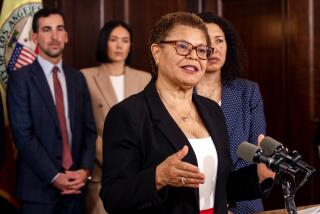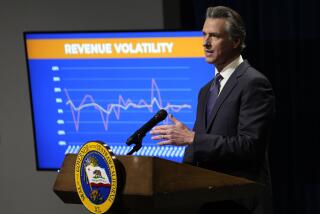City Hall Considers More Belt-Tightening to Weather Budget Shortfall : Economy: The debate centers on how to retain services with up to $29 million less income.
- Share via
San Diego city administrators hope to weather a $25-million budget shortfall without layoffs, but probably will have to cut back various programs and public services, top City Hall officials said Thursday.
In a report to the City Council, City Manager Jack McGrory, citing what he termed “Great Depression-type” declines in sales tax revenue attributable to reduced consumer and business spending, acknowledged that the city faces a $25- to $29-million shortfall in its $1.1-billion budget.
On a related matter, McGrory also recommended Thursday that the council reject two major proposals offered by Mayor Maureen O’Connor in her State of the City address earlier this month. Those two proposals--a suspension of business taxes for large companies and permitting hotels and motels to defer payment of room taxes--could cost the city more than $1 million, worsening the current economic constraints, he said.
While McGrory’s opposition to O’Connor’s plan sets the stage for a possible showdown at next week’s council meeting, it was the budget shortfall that dominated the economic debate Thursday inside and outside City Hall.
Without minimizing the problem’s seriousness, McGrory, trying to put the best possible face on the bleak news, told the council that he does not expect it will be necessary for city departments “to reduce services to the community.”
To offset the shortfall, heproposed a “recession response plan” that includes a hiring freeze, from which public safety positions would be exempted; suspension of most out-of-state travel by city staff; deferral of equipment purchases; overtime reductions, and elimination of a policy allowing workers to accept pay in lieu of vacation time.
Conceding that those cuts inevitably will affect city services and programs, McGrory argued that any resulting changes probably will not be “significant enough for the public to see.”
However, while McGrory’s department heads share his objective, they are less sanguine about the prospects of closing the budget gap without an appreciable impact on public services.
“There’s bound to be reductions in service levels--the only thing we can hope to do is minimize them,” said Park and Recreation Director George Loveland. His own department, Loveland added, could see cutbacks ranging from reduced staffing at recreation facilities to cuts in landscaping, graffiti removal and other maintenance services at parks.
Similarly, General Services Department Director Terry Flynn said the budget woes could further postpone a $50-million package of backlogged maintenance and capital improvement projects in city buildings--among them, long-delayed re-roofings, elevator replacements and upgrades of heating and air-conditioning systems.
“Things that should have been done long ago won’t get done for even longer,” Flynn said. “Some buildings already have interior water stains because of bad roofs, and problems like that probably will get worse. Maintenance is always an easy thing to cut, but you pay in the long run. It could get to the point where some buildings might have to be closed for safety reasons.”
The $25-million-plus budget shortfall outlined by McGrory was not entirely unexpected; he and the city’s financial analysts began predicting one several months ago as a logical outgrowth of the deepening recession.
The reduced spending attributable to the nationwide economic downturn has dramatically lowered sales tax receipts and revenue from other fees and permits, skewing the estimates used in calculating the budget last summer.
Though city budget officials were conservative in their estimates, the moderate economic recovery that many economists predicted would occur early in 1992 has failed to materialize, creating the gap between projected and actual revenue, McGrory stressed.
“Nobody thought it would be this bad for this long,” he said.
Most of the shortfall stems from reductions in sales tax collections, which are running $13 million to $15 million below projections. Despite San Diego’s population growth during the past three years, sales tax revenue, which accounts for 20% of the city’s $479-million general fund budget, has remained at the same level over that period--only the second time in more than 30 years that those funds did not increase annually, McGrory noted.
Exacerbating that problem, the city is receiving lower-than-projected interest rates on its investments, and revenue from fines and forfeitures is down. The state, to alleviate its own budget woes, cut the city’s share of cigarette taxes and police officer training funds by about $1.8 million.
At McGrory’s direction, city departments began deferring expenditures last month, a pattern that will continue at least until--and probably after--the new fiscal year begins July 1.
There are about 250 vacancies in the city’s 9,800-member work force, and, with the exception of police, fire and other public safety positions, most of those vacancies will remain unfilled, McGrory said. Some other vacant jobs necessary to provide “essential city services,” among them the Neighborhood Pride and Protection Program and economic development positions, also might be provided, McGrory said, “but that’s going to be done on a very, very selective basis.”
McGrory also instructed city department heads to develop contingency plans by today to reduce their individual budgets by 10%--cuts that could be implemented if economic conditions worsen this spring.
Council members, while praising McGrory’s strategy for addressing the shortfall, share that concern.
“My best guess would be that we can’t respond as quickly or as effectively,” Councilwoman Valerie Stallings said.
From the perspective of General Services Director Flynn, the new round of cutbacks could simply heighten the wishful thinking and finger-crossing he has engaged in during recent years while critical maintenance projects in city facilities were repeatedly delayed.
“I’m going to be facing the East looking for help from everybody’s God,” Flynn joked.
Park and Recreation Director Loveland, meanwhile, said park-goers could notice some aesthetic changes--among them, less well-kept grassy areas and delays in graffiti removal--as a consequence of the budget cuts.
Like McGrory and other top city officials, Loveland believes that some long-term gains could result from the forced down-scaling of city government imposed by the shortfall. By forcing city leaders to reassess current practices and search for greater efficiencies, they said, the reduced staffing and other changes could create a better, more streamlined city government.
“We’re always talking about trying to do things more effectively and efficiently,” Loveland said. “But you’re more likely to do that when you have a can tied to your tail.”
More to Read
Sign up for Essential California
The most important California stories and recommendations in your inbox every morning.
You may occasionally receive promotional content from the Los Angeles Times.










